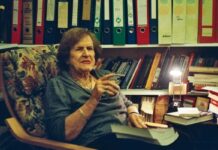Of course, it is only one of those strange historical coincidences that historians like me enjoy. George Orwell titled his famous book 1984 because he wrote it in 1948. The PKK, inspired by an ideological offshoot of (among other things) the Soviet Marxism that Orwell criticized in 1984, began carrying out acts of violence in 1984. Haruki Murakami titled his massive novel 1Q84, which is set in an altered reality of 1984.
For those intimidated by the novel’s 1000 pages, Murakami’s work is an intense and fascinating meditation on how ideological movements, whether political or religious, emerge, develop into hierarchical, self-perpetuating organizations, and eventually move beyond the control of their founders. This focus was apparently inspired by Murakami’s research on the Japanese cult Aum Shinrikyo and its 1995 sarin gas attack on the Tokyo subway. In the novel, 1Q84 is the name for the “altered” reality that people enter when they become involved in such ideological movements.
1Q84 focuses on two main characters, Aomame and Tengo, and their interactions with a cult-like organization based in Tokyo called Sakigaki. Sakigaki is originally a malevolent commune-cult that has become politically and economically powerful, and is apparently linked to sexual crimes and murders. Aomame and Tengo enter and then encounter Sakigaki in the altered 1Q84 reality, which is signified by the existence of two moons.
The Sakigaki cult itself is centered on a single founder, known only as the Leader. Aomame, a female assassin, is tasked with killing Sakigaki’s leader as revenge for sexual crimes he has committed against women. The book’s pivotal event becomes the confrontation between Aomame and the Leader, and much of the novel’s meaning should be traced to the dialogue that goes on between the two as Aomame prepares to kill him. The Leader initiates a conversation about metaphysical truth by pointing out that
Most people are not looking for provable truths. As you said, truth is often accompanied by intense pain, and almost no one is looking for painful truths.
What people need is beautiful, comforting stories that make them feel as if their
lives have some meaning…. If a certain belief – call it ‘Belief A’ – makes the life
of that man or this woman appear to be something of deep meaning, then for them
Belief A is the truth. If Belief B makes their lives appear to be powerless and
puny, then Belief B turns out to be falsehood. The distinction is quite clear. If
someone insists that Belief B is the truth, people will probably hate him, ignore
him, or, in some cases, attack him. It means nothing to them that Belief B might
be logical or provable. (2)
After several more minutes of conversation, the Leader reveals to Aomame that he understands that she was sent to assassinate him. However, that happens to be exactly what he wants. But carrying out her intention will put Aomame in extreme danger:
If you were to kill me, my people would be sure to track you down. They are asolute fanatics, and they are powerful and persistent. With me gone, the religion would lose its centripetal force. But once it is formed, a system takes on a life of its own.
(3)
After describing the altered reality that Aomame has entered, the Leader repeats his description of his cult’s members:
… if I am killed, the organization that I have created will never leave you alone…they will track you down and punish you severely. That is the kind of system that we have created: close-knit, violent, and irreversible. (4)
When I read 1Q84 upon its release in 2011, the similarities between Sakigaki and the PKK were immediately apparent. Naturally, Murakami intended Sakigaki to resemble any type of ideologically-driven, closed, hierarchical community, so the resemblance is not surprising. Murakami’s novel is focused on the manner in which such groups, devoted to a specific ideology, can escape the control of their founders and become involved in terrible crimes, no matter what the founders’ original intentions were. In fact, Murakami’s suggestion seems to be that such groups tend to develop in such a direction, that the original founder(s) will eventually lose control of the organization’s members, that the organization can naturally develop into a self-perpetuating system, and that violence and evil are the eventual outcomes.
For ten years, the question of exactly how much control Abdullah Öcalan still exercised over the PKK has been the subject of constant speculation. And indeed, over the past two years Öcalan seems to have lost the ability to dictate the organization’s actions. As far as we can understand, given all his earlier declarations to the effect that the time for violence was over, Öcalan probably did not want the current wave of violence to erupt. The problem, however, is that such ideologically-driven organizations, populated by the “absolute fanatics” they create, escape the control of their original leaders. Just look into Selahattin Demirtaş’s or Figen Yüksekdağ’s eyes when they are talking to the press about “the peoples’ resistance,” which happens to be a code word for “revolution.” Blinding, conscience-destroying ideology possesses the PKK, its hierarchy, and its members. The PKK was organized originally as a commune-cult, dominated by a Maoist ideology, requiring absolute loyalty to Öcalan, and calling for personal sacrifice to the Cause. For a long time, those who tried to leave the PKK, or were suspected of any kind of “deviationism,” were subject to summary execution.
The PKK’s guerilla leaders used the past two years of a de facto truce, ostensibly declared in order to pursue peace negotiations with the Turkish state, to organize paramilitary groups referred to by their Turkish initials YDG-H (Yurtsever Devrimci Gençlik Hareketi, or Patriotic Revolutionary Youth Movement), in towns and cities especially across the region and to some extent all over the country. The members of these urban guerilla groups are 20-somethings, plus mostly teenagers, and even children. Since October 2014 those young militants have been carrying out armed attacks on Turkish state security forces and doing their best to reenact the 1870 Paris Commune wherever they have felt able to. Everywhere, the results are invariably the same: Death, destruction, ruined lives — all in the name of a utopian goal that cannot be realized through violence. Disinformation is a simple tool for the PKK’s ideological mentality: pictures from Syria or other places are purposefully circulated as pictures from Cizre; those pictures are accompanied by distorted information designed to be as inflammatory as possible. And a Western audience, remembering what went on in Turkey during the 1990s, hence already imbued with romantic sympathies for Kurdish militants, and not understanding that the situation is now fundamentally different, falls easy prey to such propaganda.
As Murakami suggests, the ultimate trajectory for such organizations is ever-increasing violence, action beyond the control of one leader, and tragedy. This is exactly what we are witnessing now, as the PKK, and its political arm the HDP, seem to have broken away from the control of Öcalan in pursuit of their own impossible, hence probably self-destructive goal: the violent wrenching away of the predominantly Kurdish regions of southern and eastern Turkey into a “self-governing” communist-nationalist utopia. The PYD (the PKK’s northern Syrian branch) has already proclaimed it in Rojava. The PKK wants to drag all of us into 1Q84.
NOTES
(1) Murakami, Haruki. 1Q84 (New York: Alfred A. Knopf, 2011), p. 462.
(2) Ibid., p. 441.
(3) Ibid., p. 447.
(4) Ibid., p. 470.












